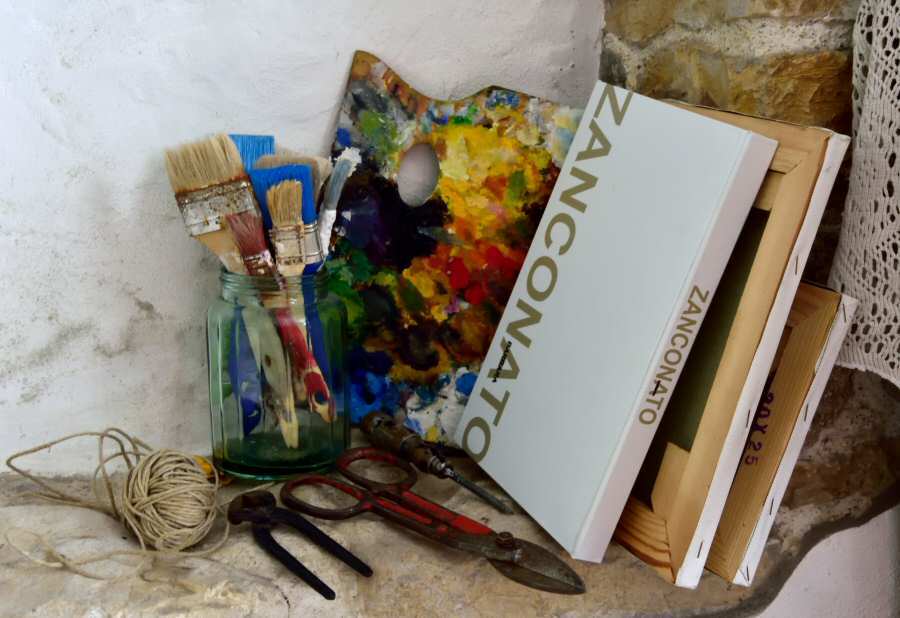My single line text



In this volume are collected and reproduced many works made by Barbara Zanconato over the past five years (2007-2012) and exposed in three major exhibitions where she was the protagonist.ZANCONATO (2012)
Unfortunately it is physically not possible to reproduce on paper the atmosphere and the emotional tension that one feels in front of her works especially if they are placed in exhibitions that enhance the reading and the deep charge of expression.
Zanconato loves personally supervising the construction of her exhibitions and this because, unlike many contemporary artists, her cycles of works are characterized by a development of very precise themes. In fact, the works, which are created with very different expressive modalities and techniques, are inserted within a sort of long speech in which every work represents a sentence, just a phrase.
That is why the Zanconato’s exhibitions are not only simple shows of works, but they become a tale, a story and, as in a book, each work represents just a moment of the overall path made up of images, words, notes and sensations, of speeches not said but seen, an invitation to reflect and to read in the works fragments of our own emotions.
This aspect strongly captures and involves most sensitive visitors as evidenced by the inscriptions left in the livres d'Or of the exhibitions and of which we find a small excerpt at the end of this collection.
Even with the limitations described above, we have tried here to return, with the help of the Author, at least a part of that atmosphere, consisting of the bond, of the dialog between the works and their sequence as it was in the shows.
According to this principle, at the beginning of the different sections we have also introduced the opening speeches of the exhibitions because, in addition to representing a direct testimony of Zanconato's poetics and her expressive intentions, they reveal to us, at the same time, her original vision of the art as a sort of programmatic manifesto.
Especially for this reason, the use of ready-mades, collages and décollages, discarded and recovery objects and materials etc.. should not be seen as a mere mention of the masters who have left a trace in her path, but as a functional and essential element for the expression of her creative tension and her artistic sensibility.
In addition, we have to consider the personal point of view of the artist particularly attentive to the women’s world (as it can be seen, for example, from the artist's books presented in final pages of this collection) and, more in general, to the world of emotions. It is interesting to note as the Zanconato's attention to the female world has not the purpose to revive outdated feminist seasons but, to the opposite, to stimulate sharing dialectic of different visions, in the belief that, in reality, we are not male and female but simply persons each one with our own diversity and uniqueness. From this point of view, the artistic production of Barbara Zanconato is constantly looking for a form of gender-free language.
There are also two other distinctive features that characterize the Zanconato's poetics clearly moving her aside from the contemporary artistic panorama and not: the first one is the vision of art as a foundamental means for the modern man's reunion with his deepest nature, hidden under layers and layers of cultural sediment that were, even unconsciously, imposed.
So art as an instrument of knowledge and liberation/appreciation of ourselves in the first place, and of what surrounds us, secondly. Art as a light to a different vision of ourselves, of the things, of the world.
A second one is the use of the art as fundamental pedagogical element that she puts in act with her activities aimed at children and adolescents, more adapted to seize the new horizons, to spread her vision of the world, inspired by the incurable optimism about the human possibilities and capacity.
Within this vision, the awareness of the new generations, less contaminated by current cultural superstructures, becomes a need as well as a distinguishing feature of her artistic activity, because her motto deeds not words is, primarily, for herself.
Andrea Falliniintroduction to the catalogZANCONATO, november 2012
limited edition,148pag., 21,7x30,5cm